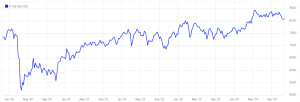Home to some of the UK’s most prominent companies, the FTSE 100 has seen plenty of activity in recent months — especially in the aerospace and defence sector.
However, a recent move by Melrose Industries (LSE: MRO) caught me by surprise. After slowly slipping 30% over the past six months, the stock suddenly surged 10% at the start of this week.
So what changed?
On Monday (28 October), Melrose published a document detailing key elements of its Risk and Revenue Sharing Partnerships (RRSPs).
These RRSPs are essentially joint ventures it holds with engine manufacturers, where Melrose co-invests in the development of specific aircraft engine programmes. Instead of just supplying parts, it also shares in the ongoing revenue generated by these engines over their lifespans, which can extend for many years.
This structure has allowed it to maintain a strong cash-generating position with projected growth in cash flows up until 2050.
“RRSPs are an important and necessary part of the aerospace engines industry with life-of-programme contracts lasting circa 50 years“, it said.
Currently, it holds a diverse portfolio of 19 RRSPs, with 17 of these projects already cash-flow positive and two more expected to turn profitable by 2028. These partnerships allow Melrose to benefit from high-margin, aftermarket revenue streams as aircraft age and need maintenance and replacements.
The portfolio’s expected to produce a total of £22bn in cash flow over the next two and a half decades.
That’s no small figure! So should I invest in the shares?
A (Mel)rose by any other name
Aerospace and defence may be a burgeoning industry but I already own similar shares in BAE Systems. Since it’s not a core focus of my investment strategy, I’d need a good reason to expose myself further.
First up, what are the risks? RRSPs sound great but require a lot of upfront investment and long-term financial commitments. They also rely on the success of specific engine programmes, so technological or regulatory changes could reduce projected cash flows.
Additionally, recovery in commercial aerospace remains gradual, which may affect near-term revenues. With mounting pressure to adopt sustainable technologies, Melrose may find itself spending more than expected.
Financial outlook
Melrose is currently unprofitable but has a good price-to-book (P/B) ratio of 1.9, well below the industry average. It has £1.17bn in debt that has reduced recently, with its debt-to-equity ratio falling from 50% to 38%.
With the investment into RRSPs expected to pay off, analysts forecast earnings to grow at a rate of 106% a year going forward. This means the company will likely become profitable sometime next year.
The average 12-month price target from 12 analysts is 650p, representing a 46.7% increase from the current level. Analysts looking at BAE only expect a 16% increase in the coming 12 months.
So after looking at the numbers, Melrose could be a better opportunity in the short term. But whether its RRSP play will pay off in the long term remains to be seen.
Overall, I think Melrose could be a worthwhile consideration for investors looking to get into the aerospace and defence industry. However, with the US election looming amid an already unstable geopolitical landscape, I’m sticking with what I know and holding my BAE shares for now.
This post was originally published on Motley Fool







